by Eric Meier
When attempting to identify a wood sample, it’s important to keep in mind the limitations and obstacles that are present in our task. Before starting, please have a look at The Truth Behind Wood Identification to approach the task in a proper mindset; I consider the linked article to be required reading for all those visiting my site with the intent of identifying wood.
1. Confirm it is actually solid wood.
Before proceeding too much farther into the remaining steps, it’s first necessary to confirm that the material in question is actually a solid piece of wood, and not a man-made composite or piece of plastic made to imitate wood.
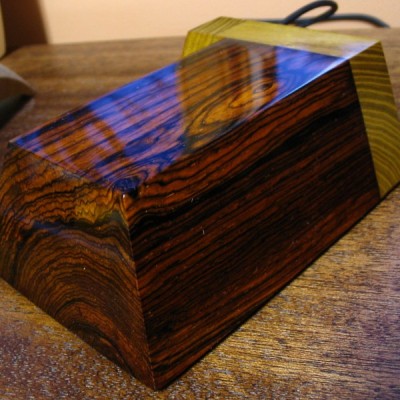
Can you see the end-grain?
Manufactured wood such as MDF, OSB, and particleboard all have a distinct look that is—in nearly all cases—easily distinguishable from the endgrain of real wood. Look for growth rings—formed by the yearly growth of a tree—which will be a dead-giveaway that the wood sample in question is a solid, genuine chunk of wood taken from a tree.
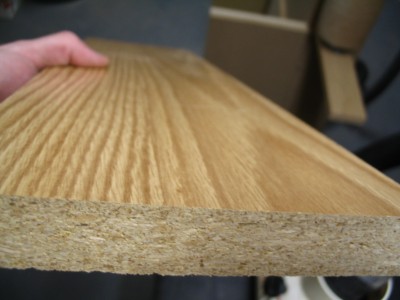
Is it veneered?
If you see a large panel that has a repeating grain pattern, it may be a veneer. In such cases, a very thin layer of real wood is peeled from a tree and attached to a substrate; sometimes the veneer can be one continuous repeating piece because it is rotary-sliced to shave off the veneer layer as the tree trunk is spun by machines. Assuming it is a real wood veneer with a distinct grain and texture—and not merely a piece of printed plastic—you may still be able to identify the outer veneer wood in question, but you should still realize that is it only a veneer and not a solid piece of wood.
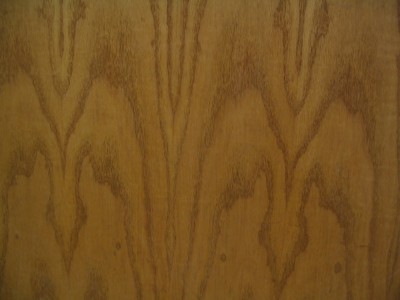
Is it painted or printed to look like wood?
Many times, especially on medium to large-sized flat panels for furniture, a piece of particleboard or MDF is either laminated with a piece of wood-colored plastic, or simply painted to look like wood grain. Many of today’s interior hardwood flooring planks are good examples of these pseudo-wood products: they are essentially a man-made material made of sawdust, glues, resins, and durable plastics.
2. Look at the color.
Some questions to immediately ask yourself:
Is the color of the wood natural, or is it stained?
If there is even a chance that the color isn’t natural, the odds are increased that the entire effort of identifying the wood will be in vain.
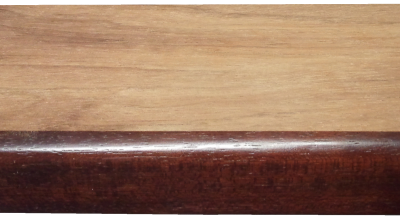
Is it weathered or have a patina?
Many woods, when left outside in the elements, tend to turn a bland gray color. Also, even interior wood also takes on a patina as it ages: some woods get darker, or redder, and some even get lighter or lose their color; but for the most part, wood tends to darken with age.
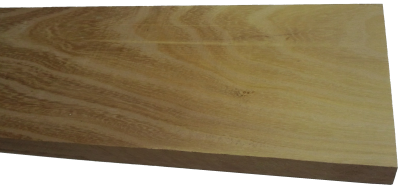
Is it possible to sand or plane the board to see the natural raw color of the wood?
The most predictable baseline to use when identifying wood is in a freshly sanded state. This eliminates the chances of a stain or natural aging skewing the color diagnosis of the wood.
3. Observe the wood grain.
If the wood is unfinished, then look at the texture of the grain. Ask yourself these questions:
Does the wood have an open, porous texture?
Most softwoods will be almost perfectly smooth with no grain indentations, while many common hardwoods have an open pore structure, such as oak or mahogany; though there are some hardwoods that are also smooth to the touch, such as maple.
Can you tell if the wood is quartersawn or plainsawn?
By observing the grain patterns, many times you can tell how the board was cut from the tree. Some wood species have dramatically different grain patterns from plainsawn to quartersawn surfaces. For instance, on their quartersawn surfaces, lacewood has large lace patterns, oak has flecks, and maple has the characteristic “butcher block” appearance.
Is there any figure or unusual characteristics, such as sapwood, curly or wild grain, burl/knots, etc.?
Some species of wood have figure that is much more common than in other species: for example, curly figure is fairly common in soft maple, and the curls are usually well-pronounced and close together. Yet when birch or cherry has a curly grain, it is more often much less pronounced, and the curls are spaced farther apart.
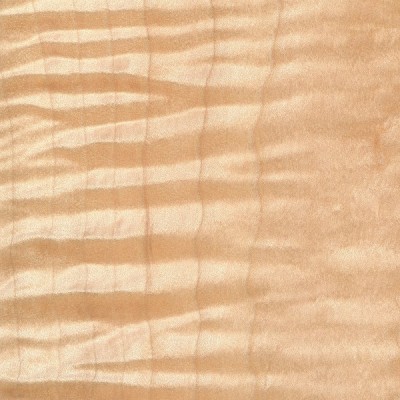
4. Consider the weight and hardness of the wood.
If it’s possible, pick the piece of wood up and get a sense of its weight, and compare it to other known wood species. Try gouging the edge with your fingernail to get a sense of its hardness. If you have a scale, you can take measurements of the length, width, and thickness of the wood, and combine them to find the density of the wood. This can be helpful to compare to other density readings found in the database. When examining the wood in question, compare it to other known wood species, and ask yourself these questions:
Is the wood dry?
Wood from freshly felled trees, or wood that has been stored in an extremely humid environment will have very high moisture contents. In some freshly sawn pieces, moisture could account for over half of the wood’s total weight! Likewise, wood that has been stored in extremely dry conditions of less than 25% relative humidity will most likely feel lighter than average.
How does the wood’s weight compare to other species?
Taking into account the size of the board, how does its weight compare to other benchmark woods? Is it heavier than oak? Is it lighter than pine? Look at the weight numbers for a few wood species that are close to yours, and get a ballpark estimate of its weight.
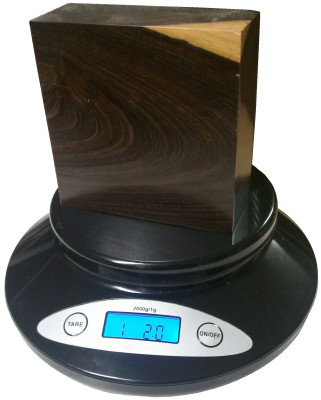
How hard is the wood?
Obviously softwoods will tend to be softer than hardwoods, but try to get a sense of how it compares to other known woods. Density and hardness are closely related, so if the wood is heavy, it will most likely be hard too. If the wood is a part of a finished item that you can’t adequately weigh, you might be able to test the hardness by gouging it in an inconspicuous area. Also, if it is used in a piece of furniture, such as a tabletop, a general idea of its hardness can be assessed by the number and depth of the gouges/dings in the piece given its age and use. A tabletop made of pine will have much deeper dents than a tabletop made of Oak. Additionally, you can always try the “fingernail test” as a rough hardness indicator: find a crisp edge of the wood, and with your fingernail try to push in as hard as you can and see if you’re able to make a dent in the wood.
5. Consider its history.
Many times we forget common sense and logic when attempting to identify wood. If you’ve got a piece of Amish furniture from Pennsylvania, chances are more likely that the wood will be made of something like black walnut or cherry, and not African wenge or jatoba. You might call it “wood profiling,” but sometimes it can pay to be a little prejudiced when it comes to wood identification. Some common-sense questions to ask yourself when trying to identify a piece of wood:
Where did it come from?
Knowing as much as you can about the source of the wood—even the smallest details—can be helpful. If the wood came from a wood pile or a lumber mill where all the pieces were from trees processed locally, then the potential species are immediately limited. If the wood came from a builder of antique furniture, or a boat-builder, or a trim carpenter: each of these occupations will tend to use certain species of woods much more often than others, making a logical guess much simpler.
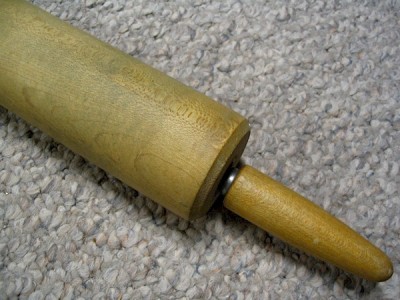
How old is it?
As with the wood’s source, its age will also help in identification purposes. Not only will it help to determine if the wood should have developed a natural patina, but it will also suggest certain species which were more prevalent at different times in history. For instance, many acoustic guitars made before the 1990s have featured Brazilian rosewood backs/sides, yet due to CITES restrictions placed upon that species, East Indian rosewood became a much more common species on newer guitars. (And this is a continuing shift as newer replacements are sought for rosewoods altogether.)
How large is the piece of wood?
Some species of trees are typically very small—some are even considered shrubs—while others get quite large. For instance, if you see a large panel or section of wood that’s entirely black, chances are it’s either painted, dyed, or stained: Gaboon ebony and related species are typically very small and very expensive.
What is the wood’s intended use?
Simply knowing what the wood was intended for—when considered in conjunction with where it came from and how old it is—can give you many clues to help identify it. In some applications, certain wood species are used much more frequently than others, so that you can make an educated guess as to the species of the wood based upon the application where it was used. For instance, in the United States: many older houses with solid hardwood floors have commonly used either red oak or hard maple; many antique furniture pieces have featured quartersawn white oak; many violins have spruce tops; many closet items used aromatic red cedar, and so forth. While it’s not a 100% guarantee, “profiling” the wood in question will help reduce the number of possible suspects, and aid in deducing the correct species.
6. Find the X-Factor.
Sometimes, after all the normal characteristics of a sample have been considered, the identity of the wood in question is still not apparent. In these instances—particularly in situations where a sample has been narrowed down to only a few possible remaining choices—it’s sometimes helpful to bring in specialized tests and other narrower means of identification.
The following techniques and recommendations don’t necessarily have a wide application in initially sorting out wood species and eliminating large swaths of wood species, but will most likely be of use only as a final step in special identification circumstances.
Odor
Believe it or not, freshly machined wood can have a very identifiable scent. When your eyes and hands can’t quite get a definitive answer, sometimes your nose can. Assuming there is no stain, finish, or preservative on or in the wood, quickly sand, saw, or otherwise machine a section of the wood in question, and take a whiff of the aroma.
Although new scents can be very difficult to express in words, many times the scent of an unknown wood may be similar to other known scents. For instance, rosewoods (Dalbergia spp.) are so named for their characteristic odor that is reminiscent of roses. Although difficult to directly communicate, with enough firsthand experience scents can become a memorable and powerful means of wood identification.
Fluorescence
While certain woods can appear basically identical to one another under normal lighting conditions, when exposed to certain wavelengths—such as those found in blacklights—the wood will absorb and emit light in a different (visible) wavelength. This phenomenon is known as fluorescence, and certain woods can be distinguished by the presence or absence of their fluorescent qualities. See the article Fluorescence: A Secret Weapon in Wood Identification for more information.
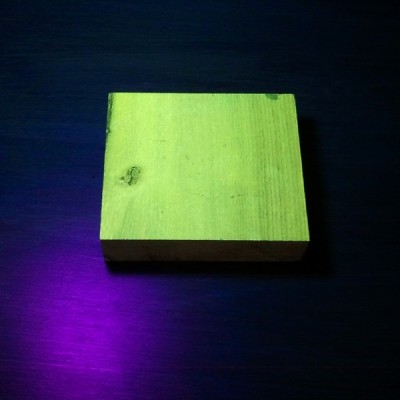
Chemical Testing
There are only a small number of chemical tests regularly used on wood, most of which are very specialized and were developed to help distinguish easily confused species with one another. They work by detecting differences in the composition of heartwood extractives. A chemical substance (called a reagent) is usually dissolved in water and applied to the wood surface: the surface is then observed for any type of chemical reaction (and accompanying color change) that may occur. Two of the most useful are the tests that are meant to separate Red and White Oak, and Red and Hard Maple.
Heartwood Extractives Leachability
Sometimes a wood species will have heartwood extractives that will be readily leachable in water and capable of conspicuously tinting a solution of water a specific color. For instance, the heartwood extractives contained in osage orange (Maclura pomifera) contain a yellowish-brown dye that is soluble in water. (This can sometimes be observed anecdotally when the wood is glued with a water-based adhesive: the glue’s squeeze-out is an unusually vibrant yellow.)
In a simple water extract color test, wood shavings are mixed with water in a vial, test tube, or other suitably small container, and the color of the water is observed after a few minutes. If the heartwood extractives are leachable by water, then a corresponding color change should quickly occur.
In addition to osage orange (Maclura pomifera), merbau (Intsia spp.), and rengas (Gluta spp. and Melanorrhoea spp.) are also noted for their readily leachable heartwood extractives. Because this property is quite uncommon, it can serve to quickly differentiate these woods from other lookalikes.
7. Look at the endgrain.
Perhaps no other technique for accurate identification of wood is as helpful and conclusive as the magnified examination of the endgrain. Frequently, it brings the identification process from a mostly intuitive, unscientific process into a predictable, repeatable, and reliable procedure.
Looking at the endgrain with a magnifier shouldn’t be a mystifying or esoteric art. In many cases, it’s nearly as simple as examining small newsprint under a magnifying glass. There are three components necessary to reap the full benefits contained in the endgrain:
I. A prepared surface.
When working with wood in most capacities, it becomes quickly apparent that endgrain surfaces are not nearly as cooperative or as easily worked as face grain surfaces. However, in this case, it is absolutely critical that a clear and refined endgrain surface is obtained.
For a quick glance of a softwood sample, a very sharp knife or razor blade can be used to take a fresh slice from the endgrain. However, in many denser species, especially in tropical hardwoods, one of the best ways to obtain a clear endgrain view is through diligent sanding. It’s usually best to begin with a relatively smooth saw cut (as from a fine-toothed miter saw blade) and proceed through the grits, starting at around 100, and working up to at least 220 or 320 grit, preferably higher for the cleanest view.
II. The right magnifier.
It need not be expensive, but whatever tool is used to view the endgrain should have adequate magnifying power. In most instances, 10x magnification is ideal, however, anything within the range of 8 to 15x magnification should be suitable for endgrain viewing. (Standard magnifying glasses are typically in the range of 2 to 4x magnification.)
These stronger magnifiers, sometimes called loupes, usually have a smaller viewing area than standard magnifying glasses. Fancier models—with built in lights, or larger viewing surfaces—are available at a premium; but the most basic models are usually only a few dollars.
III. A trained eye.
The third element that constitutes a proper endgrain examination is simply knowing what to look for. In analyzing the patterns, colors, shapes, and spacing of the various anatomical features, there is a veritable storehouse of information within the endgrain—all waiting to be unlocked. Yet, if these elements have not been pointed out and learned, the array of features will simply seem like an unintelligible jumble. The discipline of recognizing anatomical endgrain features is not easily summed up in a few sentences or even a few paragraphs, but it is nonetheless critical to the identification process. To this end, an in-depth look should be given to the various categories, divisions, and elements that constitute endgrain wood identification on the macroscopic level. (In this regard, macroscopic denotes what can be seen with a low-powered, 10x hand lens—without the aid of a microscope—rather than simply what can be seen with the naked eye.) Because the anatomy between softwoods and hardwoods is so divergent, each will be considered and examined separately:Still stumped?
If you have a mysterious piece of wood that you’d like identified, you’ve got a few options for next steps:USDA’s Forest Products Laboratory
You can mail your physical wood samples to the Center for Wood Anatomy Research.
Pros:
- Free
- Professional wood identification
Cons:
- Only available to US citizens
- Slow turnaround times (up to a month or more)
- Limited to three IDs per year
See their Wood ID Factsheet for more info.
Alden Identification Service
You can mail your physical wood samples (even small sections taken from antiques) to Alden Identification Service.
Pros:
- Professional wood identification
- Faster turnaround times (ranging from a few days to a week or two)
Cons:
- Paid service
See their ordering page for more info. (Note that Harry Alden has written several books while at USDA, including both Hardwoods and Softwoods of North America.)
Ask for help online
If the wood ID is merely a curiosity, or non-critical, you can post pictures of the wood in question.
Pros:
- Free
- No need to send physical samples
Cons:
- Greatly limited by the quality of the pictures provided
- Extra work usually required to get adequate clarity in photos
See article of Common US Hardwoods to help find the most commonly used woods.
Get the hard copy
 If you’re interested in getting all that makes The Wood Database unique distilled into a single, real-world resource, there’s the book that’s based on the website—the Amazon.com best-seller, WOOD! Identifying and Using Hundreds of Woods Worldwide. It contains many of the most popular articles found on this website, as well as hundreds of wood profiles—laid out with the same clarity and convenience of the website—packaged in a shop-friendly hardcover book.
If you’re interested in getting all that makes The Wood Database unique distilled into a single, real-world resource, there’s the book that’s based on the website—the Amazon.com best-seller, WOOD! Identifying and Using Hundreds of Woods Worldwide. It contains many of the most popular articles found on this website, as well as hundreds of wood profiles—laid out with the same clarity and convenience of the website—packaged in a shop-friendly hardcover book. 


Why I will no longer be replying to every wood ID request I’ve replied to literally thousands of wood ID requests on this site over the past 13+ years, but as the site’s popularity has grown, so has the time demands for ID on a daily basis. (Contrary to what some may seem to think, I am not some all-knowing wood wizard that can instantly ID your wood. It can actually take me a long time to sift through a lot of different resources.) Over the past few years, my backlog of pending wood species to be added to the… Read more »
Hi, I’m wondering what kind of wood is this. It’s an old bed frame. I’m thinking maybe maple but not sure.
Doesn’t look like maple to me. I see some interesting ray fleck patterns on your first pic, so that should narrow it down quite a bit. Seeing a closeup image of the end grain once it’s been finely sanded should help give a better chance of ID.
Hello
i have this remnant timber from a large house, the lumber supposedly came from an old timber structure in Europe. The wood is very heavy and ruins bandsaw blades and smells horrible when cut. It splinters when turned.
If you can help, that would be great.
Can you help me identify this wood?
Looks like a species of softwood such as pine.
hi!! would be very grateful if you could hazard a guess as to the type of wood. thank you so much!
The grain superficially looks like mahogany, but I can’t tell too much more from the pics. It appears to be darkly stained, so I can’t see the grain/anatomy clearly.
what kinds of pictures can i take n order for you to see thr grain better? Thank you!
It’d be pretty tricky to get a good ID since the furniture may be veneered, and also is likely made from different types of wood throughout the piece. Seeing pictures of unstained / unfinished wood inside the drawers might help, but that may just be an entirely different species of wood regardless.
Hi Eric I have a table I want to refinish but I don’t know what kind of wood it is. The set has matching chairs that I am not going to use. I stripped the chair seat down to the raw wood. It came off fairly easy with a mouse sander. I’m attaching a before and after picture. It appears to be a sold very hard wood. The set is very heavy. I think it’s only 7 or 8 years old and stamped Thomasville. The first two pics are before I sanded it down. First is the table top and… Read more »
That looks like rubberwood, sometimes also referred to as plantation hardwood. https://www.wood-database.com/rubberwood/
Thank you so much! You are right. I was so puzzled. Looks just like butcher block!
Hi. You are amazing! I have a coffee table of unknown origin I was given. I want to refinish it and am wondering the wood type. Any thoughts?
The bottom is unfinished the ends have a whitewash on them. Any help greatly appreciated.
Hi What an amazing resource! Kudos to you for the hard work. I wonder whether you could take a look at the photos I’ve posted? It’s a ‘barn find’ type of story. I was invited to a sadly deceased woodworker’s small workshop by his widow to see if I could ‘make use’ of the contents (been left for over 12 years). The gent saw military service in Africa many decades ago, but somehow managed to bring home lots of exotic timbers for his use making instruments. There was a lot of Wenge, but also the piece in the photos. I’ve… Read more »
That very much looks like sapele with a “pommele” figure. The only other wood that I know of that commonly has this type of figure is bosse, but generally the heartwood is not quite as reddish as sapele.
Thank you for looking at this, Eric. For such a stunning piece of wood, it had been used as a shelf! Will think long and hard about what to make from it now.
Hi Eric, thank you for this beautiful website and for sharing your knowledge!
Any ideas on what species of wood this could be? It’s from a mid-century style coffee table. The wood is reddish in colour, and in the last photo the round area in the middle is the appearance of the grain when wet (the rest has been sanded).
Many thanks!
It is a diffuse porous hardwood, which would generally point to something imported from a more tropical location. Unfortunately, diffuse porous tropical hardwoods are some of the hardest to get a positive ID on. There are probably dozens of likely candidates. Some guesses that come to mind at first would be macacauba, or possibly a species in the Guibourtia genus. https://www.wood-database.com/wood-filter/?fwp_genus=guibourtia
That’s really interesting, thanks a lot!
I am in the process of refinishing a Mid Century dresser and would love some help with identifying the veneer wood type.
Hard to tell from the pics, but at least superficially it looks closest to mahogany to me.
Thanks
Found these cut pieces in a residential area of Lubbock, Texas. Sanded the end-grain with 80 grit sandpaper and water popped it right before taking this pic. Any help on ID would be really helpful. Thanks!
Looks like a beautiful piece of wood, though I don’t feel confident enough to put forth any guesses upon seeing the endgrain from this distance. Getting a closer view of the endgrain to see the anatomical features would be helpful. Also, if you ever mill or cut up these pieces, I’d be interested to see what the face grain looks like too.
Here is a closer pic of the endgrain. I also chopped up a small piece to get a profile of the wood. Beautiful reds, browns, and oranges. Fat sapwood.
It reminds me of two very similar woods, Kentucky coffeetree and honey locust. If it really is one of these two woods, both woods should glow a vibrant yellow-green under a blacklight. https://www.wood-database.com/wood-articles/fluorescence-a-secret-weapon-in-wood-identification/
Honey locust will also have thorns on the tree, so if you have any branches or foliage that you can remember, that might help narrow things down as well.
Hi! I’m looking for identification of this (very, very heavy) wooden table. Currently in the process of sanding and will oil soon. Bought second hand so no unfortunately there’s no history or store label.
Refinished my table and my sander got away from me. Considering patching it up wit veneer. Not sure what type of wood it is or if there is a better way to repair it.
It looks like you’ve sanded through the top layer of veneer. It would be a pretty difficult and labor intensive repair to do if you’re wanting a perfect end result. Basically you’d have to apply a new veneer layer to the entire affected wood surface and refinish.
I was given a large sheet of veneer to repair a table top but I do not know what type of wood it is. Can you help with an ID on it to help with choosing a proper finish. Thank you!
At the very least, the grain is mahogany-like. Can’t tell for sure on the species from just a facegrain look, but it should take stain and finish well regardless.
Got this end table for $5 at Goodwill with an old chipping finish and red stained. Sanded it down to this to reveal a gorgeous wood.
Someone saw this picture and said it looks like an exotic wood so now I’m curious.
It’s attached to other wood for the base and legs so hard to be sure about weight but it’s not heavy. Very smooth and harder to scratch/dent.
That looks like black walnut veneer. It’s an interesting grain pattern, bordering on burl, but I would just called it “figured” walnut veneer. When two consecutive veneer slices are cut and opened side by side, it’s a book-match. When another two are opened and put end to end, it’s a butt-match. With all four, it’s sometimes called a book and butt match, or sometimes just quad matched.
While in Florida my neighbor showed me a blank he had purchased, 18 inches by 3.5 inches by 8 feet. He asked me to go with him to a a saw mill to reduce it’s size. The water fueled saw produced a board with a red surface… I took a scrap piece home thinking I could use it as a contrast in the cutting boards I make in my shop. To my disappointment when it dried it was brown and looked but did not smell like walnut. Is this a species from Florida and what would type of wood do… Read more »
Hi Eric, I had visited and antique shop to get a used antique sofa set. The person claimed its rosewood. It was fairly heavy but i can’t verify its claim. if by chance can you see from the image and tell, which i know its very difficult as i have got only one picture. Thank you
Hi, sorry I can’t tell from that single picture. I’d need to see a closer shot of the grain to have a better chance at an ID.
Thank you Eric!
I am trying to duplicate this fireplace. What kind of wood do you think this is? Straight grain, stains brown with visible grain for clean. contemporary look.
The color would be trying to replicate black walnut, so either using that wood, or a stain (close to black walnut’s color) on another hardwood would come close to that look.
I sanding down the kitchen cabinet sitting on the hardwood floor. I would like to know which wood the cabinets are–and I’d love a positive ID of the flooring too
I’m really thankful that you take the time to help people out with identifying wood types!
I wanted to send you a better picture of the table top just to make sure that you think this is black walnut. I feel like my last picture didn’t look very complete
Thank you!!!
Yes, that looks like black walnut to me.
Hello can anyone help me identify our wooden table. It is very heavy though
Any idea what kind of wood my floors are. House was built in 1905 and I believe it’s original. All picture are the same floor just taken from the top and bottom
Please reattach pic(s) and possibly resize to smaller size, they didn’t come through.
The first photo is the bottom of the board viewed from the basement.
I can’t make out very much details in most of the pics, but in the third pic I can see the grain clearly enough to see that it’s a softwood, possibly pine.
From different angles
Hi again, Eric. I’m hoping you can help identify what we’re working with again. We found this high chair in a storage building on our property, so we’ve sanded it and generally cleaned it up. This property has been a treasure trove of mid-century modern odds and ends; almost like time stopped in the mid 50’s. To my admittedly untrained eye, it looks like cedar, but no amount of sanding is yielding that distinctive cedar smell. Thanks in advance.
Looks like a softwood species. From your endgrain picture, I can’t make out any resin canals, which would rule out pine and possibly also spruce (assuming that your picture is showing sufficient detail to make out the presence of resin canals). If the wood is more or less odorless, it may be something like hemlock or fir.
Hello, I just purchased this home from the 1970s, and it looks like the floors are hardwood. I called around, and a couple of companies would like to charge me anywhere from $5000 to $10000 to have them sand the floors with a sanding machine. Can you help me identify if these floors are hard or will I get ripped off if I allow them to sand them? Thank you.
Please re-attach pics, they didn’t come through.
Here you go, Eric. I hope they come thru this time, and thanks.
I have purchased several old doors from a salvage shop in Cleveland, Ohio to refinish and put in my house. I have been unable to find the correct size for one of my doorways so I might have it custom made, but am trying to decide what species to make it out of based on the species of the old doors I purchased. I am thinking pine, but of course I don’t know. The first three pictures are from one door, the 4th picture is from a different door. Any guesses are much appreciated!
They all look like softwoods with a reddish brown stain applied. The fourth looks like a species of southern yellow pine or possibly Douglas fir. The other three may just be a softer wood like fir or spruce. Either way, I think the biggest part of the challenge with color matching will be in the getting the right stain color. Softwoods can also be difficult to stain evenly so you may want to look into a gel stain or something that is meant specifically for softwoods and other hard to stain woods.
Thanks for that information! Do you think it’s possible that these doors are shellacked instead of stained, and have just darkened over time?
It’s possible, but usually old doors have at least some tint in the original finish to give it just a little extra color.
Hi again.
I have a dining table that looks to be from 1869.
The stamp looks fairly clear, besides the ‘6’.
I’m curious about the word from which it was made. I don’t know if there is one type or more.
Thanks so much.
Not sure if this was a repeat of the last post, or something different, as the pics are different, except the date stamp appears to be the same picture. With the exception of the date stamp, the other photos appear to be black walnut.
Hi there.
my grandpa refinished furniture for a living in Okemos, MI.
I inherited this dining table that has some writing that I can see clearly’ December 14, 18(6?)9’….as well as some other #s.
not sure which type of wood was used if not a combination.
than you for taking the time!
Annie
The table top definitely looks like black walnut, but the wood underneath where the stamp with the date may be something different that was just stained to match the color of the walnut — possibly ash?
I’m so appreciative that you took the time! 12 years ago, I had a refinisher remove the cream paint from the underside. All was refinished. I might send more photos of underneath, as I’d like to find out if it is ash. Thanks for being so helpful
Hi! Can you help me identify the type of wood in my house?
Thanks!
It looks mahogany-like. I see ripple marks from storied rays, which would suggest either genuine mahogany (Swietenia species) or possibly sapele. https://www.wood-database.com/sapele/
Thank you so much!
Hi! I am hoping you can help identify this flooring. It is around 70 years old and I am sanding to stain/refinish my living room. The house was originally owned and built by a reputable builder and everything seems to have been done really well. I can’t tell weight but it is definitely hard and does not scratch easily. A wire brush will remove dirt from the grain without seeming to do too much damage. One picture is of an area where I did this trying to find the best way to get all the dirt out. I’m not even… Read more »
Can you try to re-attach the pictures? None of them came through.
I have tried again several times but they will not attach. I see they did not the first time either. Maybe the files are too large. I will try one at a time.
One
Two
Three. After reading more from your site I think it’s mostly red oak with maybe some white oak mixed in. I’m having a hard time toning out the red. I’ve been trying to find some of the greener stains mentioned. Another site, or maybe it was this one, said minwax is not good to use. How do you feel about that comment and could you recommend a good stain?
I’m trying to get a color like this.
That’s going to be very tough to match because that is a man-made product meant to replicate a wide amount of natural color in oak. The left part of that cutoff is much more of a neutral grayish color, while the right side is a warmer reddish brown, so difficult to match.
I’m trying to find out what kind of wood this is. Any ideas?
Looks like a lightweight diffuse porous hardwood such as yellow poplar.
I have a table that I need to identify
Hey I’ve got this pizza peel that has a strange wood in it that I was given. Can anyone help identify the one with the red arrows? TIA
I found this piece of wood on a beach on the east side of the Big Island Hawaii. It’s a hardwood. I’m doing a carving but have do idea what type of wood this is. The surface shown has just been sanded. Can anyone help me identify this?
Hi, just finished this peice of wood and is wondering what wood it is, not exaclry sure but I think it is cherry. Confirmation of what type of wood would be excellent thank you!
I purchased a renovated Barnhouse and am now selling it. There has been some controversy as to whether the shiplap walls are pine or cedar. It is difficult to tell since it has been stained and polyurethaned and the walls are now 20 years old and have yellowed as well. I cannot take a sample to someone to look at since the only boards I have are on my walls. It would be nice to know which type of wood it is since it will greatly affect the value of the home. And maybe it’s a mix of the two.… Read more »
We were given this table which I have sanded. Would appreciate if you can look at it and provide any information about the type of wood. The dark sections make me think walnut, but I have not seen a lot of walnut and what I have seen did not have light coloring also.
Table and end grain.
There’s really only two commonly used species in Asia where makers will use that much sapwood along with the heartwood. Sheesham and teak. I think given the slightly darker color of the heartwood, and the location in India I would be more inclined to say it is sheesham wood, sometimes called sissoo.
Thank you! I googled “sheesham” and saw a table that looked very similar. I have also been reading about sheesham wood which I had never heard of.
Hello, was hoping somebody could tell me what type of wood this is, home was built in 1983, pretty sure these are the original floors. We’re hoping to possibly sand and stain to a darker color. Just from reading around a little to me it seems like a repeating pattern, or strips, so maybe it’s a veneer? But really have no idea.
The difference in color in pictures is just different lighting.
That’s bamboo. Those little horizontal lines, called “nodes” in bamboo, isn’t’ really seen in regular trees because of totally different way they grow.
Thanks Eric! Appreciate the reply. I tried reading online about sanding/staining bamboo floors and it appears the answer is “maybe”. Any insight in that regard?
I’ve never stained bamboo, so I can’t comment on that. Maybe a gel stain or something formulated for harder-to-stain woods might be more helpful than just regular stain.
it is heavy has reddish color 2.6 ponds 41/2in wife and 3/4 inch thick 36 inch long .put this together . we found in a old shed that was given to us makes beautiful boxes . first pic dry 2 pic wet please help . it has curls and figured
Hi, I’m trying to identify this wood. It was part of a “mixed box” of wood I bought long ago, which included everything from maple and spruce to mahogany and rosewood. When I unpacked it I thought it might be Bahai tulipwood. But now, fifteen years later, I think I might have been wrong. When jointing and sanding the pieces, I didn’t get the expected dalbergia smell.
For the second picture I wiped one side with mineral spirits.
Thanks in advance for your help.
Erich
It could be a fruitwood of some sort, possibly cherry or pear. Definitely doesn’t look like tulipwood.
Found an old 18th century Taiko drum made from a single log. About 19” diameter. Interior was cut with some sort of gauge tool. Surface quite rough. But the grain is tight and beautiful.
Grain of wood. I don’t think the Japanese craftsmen were using African would yet in 1780 which is purportedly the age of this drum.
Hi there, trying to sell some furniture but unsure of the wood type. Any help would be appreciated! Bought it about 5 years ago in South Africa.
Good morning. This is an antique backgammon game that I’m restoring …. any idea what wood this would be ? Thanks so much.
David (from France)
Hmm, the orangish color is interesting. It’s very hard to say since I don’t know what type of finish could be applied. I would say based on your location, a VERY tentative guess might be French walnut, but that is just a very limited guess based on the wood possibly having a paler natural color with an orangish finish over top. Perhaps someone with more knowledge of what woods were more commonly used in your region can chime in.
What species of wood is this? I’m in the Dallas area and it’s from recycled pallet wood. I thought it might be cedar but now I’m not sure.
Looks like a species of oak.
I purchased this solid wood bed frame on offerup. I’d love to know the type of wood so I can buy matching furniture. The bed is stamped “made in Canada”. Please help me ID, thanks!
We got this hewn beam sample online that we are trying to re-create. Weight was hard to say because it is so small. Would appreciate your expertise on the subject. We were thinking maybe Sassafras but not quite sure. Thanks for your time!
I think the most likely candidate would just be a species of ash.
I turned this bowl on a lathe with a piece of scrap mystery wood. It has walnut oil on it to finish it. The walnut oil I use doesn’t seem to change the color. There was no odor I could detect while turning it. This bowl is really light but I’m not sure what balsa feels like
Have you worked with walnut before? That’s what it looks closest to to me. Walnut does have a faint but distinct scent though.
My husband is currently building a table out of Black Walnut. This bowl definitely doesn’t have the smell that the walnut does. Plus the walnut bothers my allergies where this didn’t.
I purchased this through an online seller and would like to buy other furniture that matches. I cannot figure out what type of wood it is and would love any help I could get. It may smell slightly like licorice.
I can’t tell the species from that pic, but I can say superficially that the color and grain are close to black cherry, so you could look for cherry furniture if you wanted to try to match that look.
Thank you very much.
The wood is a tabletop and I don’t know where it came from. It is heavy. I can’t compare it to oak, Im not that knowledgable (I’m 6′ 200lbs and 38 years old for reference of who is considering it heavy). It’s a hard wood – I’ve gone through several sheets of 40 grit sandpaper on an orbital sander to try and level it out. About 8 solid hours of sanding and I’m still not there, so it’s dense (and so am I for not breaking down and just buying a belt sander). It doesn’t smell like anything that I… Read more »
Hard to say for sure. It’s definitely a diffuse porous tropical hardwood, but there’s so many that look similar. It might be mango. The yellow discoloration may simply be discoloration within the wood itself and not just a superficial yellowing (e.g., you may not technically ever sand through it as it may go all the way through the wood).
I’m usually against using stain, but this may be an instance where, assuming the discoloration goes all the way through the wood, it might make sense to stain it a darker color to try and even out the color variation.
Hi, I’m trying to help my friend figure out what this hard wood from Oslo is. I only have pictures of the wood so I couldn’t feel the weight and the scent of the wood. Any help would be appreciated! Cheers!
Cabinets made in Quebec Canada. Does anyone know what type of wood?
The cabinet interior looks like birch or maple plywood. Hard to say on the front since it appears to be stained to resemble black cherry, but it may not really be cherry.
Sorry, I know nothing about wood, but would
like to match my floors. What kind of wood floors are these? Oak?
Yes, looks like red oak